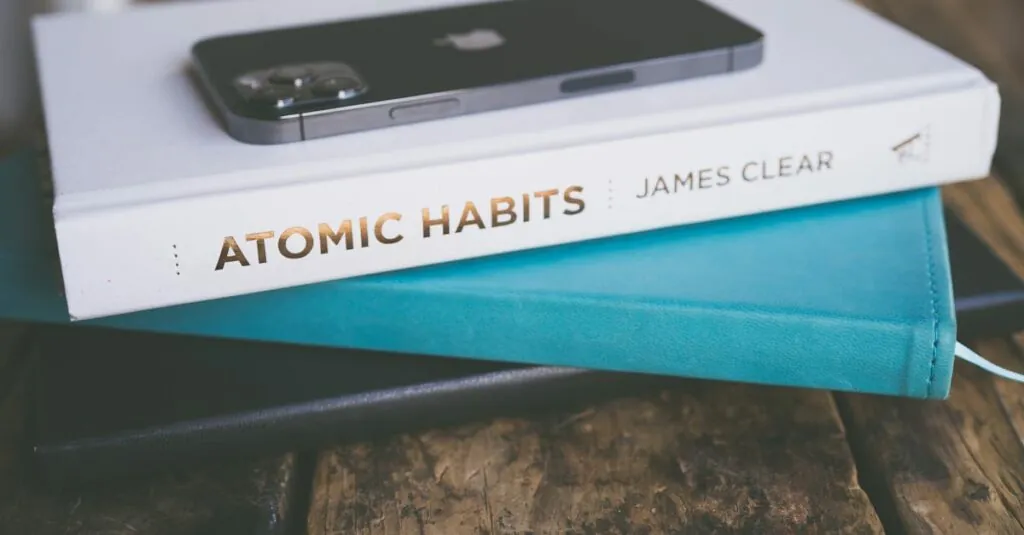Table of Contents
ToggleEver felt like your day is a never-ending game of whack-a-mole? You tackle one task only to have three more pop up in its place. Enter habit stacking—the superhero of productivity that swoops in to save the day! By linking new habits to existing ones, it turns the mundane into a powerhouse of efficiency.
Imagine brushing your teeth while doing squats or sipping coffee while journaling. Sounds a bit wacky, right? But that’s the beauty of habit stacking. It’s not just about getting things done; it’s about making life a little more fun. So, buckle up and get ready to transform your daily grind into a seamless flow of good vibes and productivity. Who knew stacking habits could feel like building a tower of awesomeness?
What Is Habit Stacking?
Habit stacking is a technique that combines a new habit with an existing one. By linking activities, individuals can create seamless transitions in their daily routines. This method leverages the established neural pathways of existing habits, making it easier to adopt new behaviors.
For example, someone might choose to do squats while brushing their teeth. This practice allows them to incorporate physical activity into a daily routine without needing extra time dedicated to exercise. Another example includes journaling during morning coffee, which transforms a simple act into a time for reflection and mindfulness.
Habit stacking enhances productivity by utilizing established behaviors as cues for new actions. By recognizing current habits, individuals identify opportunities for stacking. Strategies may involve stacking habits based on time, location, or emotional readiness.
Choosing specific habits to stack increases the likelihood of consistency. It makes the new habit feel less imposing. Stacking provides a gentle nudge toward personal growth within a familiar context.
This approach can also elevate the enjoyment of routine activities. It turns mundane tasks into engaging opportunities for development. Habit stacking encourages a more enjoyable experience while enhancing efficiency in daily tasks.
Incorporating habit stacking into daily life fosters a culture of continuous improvement. He or she creates an environment where positive habits flourish. Success arises not from grand changes but through small, manageable adjustments made consistently over time.
Benefits of Habit Stacking
Habit stacking offers multiple advantages that enhance personal routines. Improved productivity occurs as new habits seamlessly integrate into existing ones, eliminating the need for additional time. By leveraging established routines, individuals can tap into their existing momentum. This approach minimizes decision fatigue while creating efficient workflows. In practice, someone might find themselves enjoying increased output from simple habit pairings.
Enhanced motivation emerges as habit stacking makes new behaviors feel less daunting. Stacking enjoyable activities with challenging ones creates a sense of accomplishment. When a task becomes associated with a positive experience, it transforms the overall mindset. For instance, connecting mundane chores with favorite pastimes cultivates enthusiasm. As motivation strengthens, individuals often adopt new habits more readily, fostering a cycle of continuous growth.
How to Create Your Habit Stacking Example
Creating a habit stacking example involves understanding existing habits and selecting new ones that fit naturally. This method maximizes daily productivity and makes routines more engaging.
Identifying Your Existing Habits
List daily routines people already perform. Morning rituals like brushing teeth or drinking coffee often serve as great starting points. It’s important to recognize small habits such as checking emails or walking the dog. These actions act as anchors, paving the way for integrating new behaviors. Observe patterns and identify habits that occur consistently, as these become reliable cues for new activities. Tracking weekly routines can also highlight strong candidates.
Choosing New Habits to Stack
Select new habits that align with existing ones. New behaviors should be simple and enjoyable to ensure consistency. Consider fitness goals like doing push-ups while waiting for coffee to brew. Incorporating mindfulness practices, such as deep breathing during meal prep, enhances everyday tasks. Aim to prioritize beneficial habits that complement lifestyle changes. Propose one or two new routines to initiate the stacking process. This approach keeps changes manageable, empowering individuals to gradually build upon their successes.
Real-Life Habit Stacking Examples
Habit stacking provides practical applications for daily routines. Incorporating this technique into various aspects of life can enhance efficiency and satisfaction.
Morning Routine Stack
Successful mornings often begin with habit stacking. A common example involves pairing hydration with waking up. After reaching for a glass of water, individuals can follow with a few minutes of stretching. Completing this quick routine sets a positive tone for the day. Another effective combination includes brewing coffee while jotting down intentions for the day. Engaging in these activities simultaneously creates momentum and encourages a mindful approach to the morning.
Evening Wind-Down Stack
Evenings can benefit from structured habit stacks too. After dinner, relaxing with a book while sipping herbal tea can signal the body to unwind. This combination promotes relaxation and helps transition into a restful state. A great pairing might involve practicing gratitude by writing down three positive experiences from the day while preparing for bedtime. Incorporating these evening rituals enhances overall well-being and fosters a peaceful end to the day.
Tips for Successful Habit Stacking
Identify habits that align with personal routines. Starting with existing habits establishes a solid foundation for integrating new ones. Aim for simplicity when selecting new activities, ensuring they relate to daily life. Use specific triggers from established habits to create natural transitions.
Track routines to pinpoint reliable cues. Observing patterns throughout the week reveals opportunities for effective stacking. For example, if one brushes their teeth in the morning, doing a few squats while brushing enhances physical health.
Incorporate enjoyable elements into habit stacks. Pairing a new task with a favorite activity boosts motivation, making the process more engaging. Drinking tea while reviewing the day’s accomplishments combines relaxation and reflection, providing a calming effect.
Set achievable goals for habit stacking. Starting small minimizes overwhelm, allowing time for adjustments as needed. Integrating five minutes of stretching after morning coffee builds consistency without significant time investment.
Reflect on progress regularly. Reviewing successes reinforces commitment and highlights areas for improvement. Acknowledging accomplishments cultivates a positive mindset that fuels ongoing habit development.
Stay persistent even when challenges arise. Routines change, and flexibility helps adapt to new circumstances. If a particular stack doesn’t work, modifying it allows for continual growth and improvement.
Embracing habit stacking can transform daily routines into more efficient and enjoyable experiences. By linking new habits to existing ones, individuals can enhance productivity while minimizing decision fatigue. This method not only fosters consistency but also turns mundane tasks into opportunities for personal growth.
As readers explore their own habit stacking possibilities, they’ll find that small adjustments can lead to significant changes over time. With practical tips and real-life examples, the journey towards a more fulfilling routine becomes not just achievable but also exciting. By integrating enjoyable elements into habit stacks, motivation flourishes, paving the way for a culture of continuous improvement.






